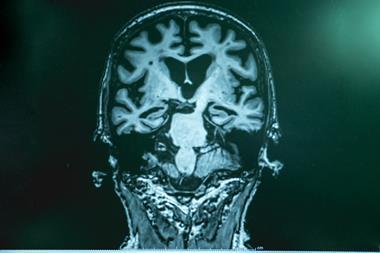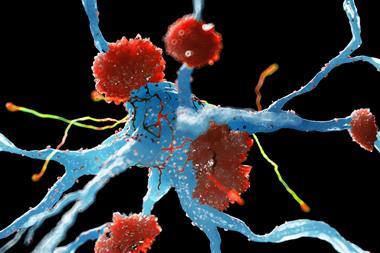A protein fragment from the brain could be used to track progression of Alzheimer’s disease. The tell-tale fragment of tau protein was detectable in the cerebrospinal fluid (CSF) of patients with the disease, and researchers now hope to develop a blood test using it.
Alzheimer’s is a disease of errant protein aggregates that include amyloid plaques and then later tau tangles. ‘Amyloid plaques begin to form about 10 to 20 years before the first symptoms of Alzheimer’s,’ says Randall Bateman, a neurologist at Washington University School of Medicine who helped lead the study. ‘Whereas tau tangles begin once the symptoms begin.’
Studies in two patient groups, each with hundreds of people, revealed that levels of the fragment in the CSF were indicative of tau clumps in the brain seen on imaging and were linked to symptoms of cognitive decline.
A recent review noted that phosphorylated tau seems to increase before symptoms appear and then continue to rise during early Alzheimer’s disease. Having a marker detectable in the blood that reflects the levels of tau tangles could allow doctors to track the disease’s progress. Today, the best way to track insoluble tangles of tau protein is to use positron emission tomography (PET) imaging, but this requires complex equipment and is expensive.
This is not the first tau fragment reported as a possible marker for Alzheimer’s, but other tau fragments were often associated with amyloid plaques rather than tau tangles, according to Bateman and his collaborators in the US and Europe. Recent clinical trials revealed substantial reductions in these fragments in the CSF of patients given anti-amyloid therapies. This suggests that they reflect amyloid plaque status. Also, levels of the tau fragments rise in mice with amyloid plaques, even with no tau tangles, the researchers note.
The important protein fragment ‘doesn’t seem to be related to amyloid plaques at all and seems to be a marker of only when there’s tau tangles in the brain’, Bateman points out. Therefore, it may better reflect the level of tau tangles in the brain, irrespective of amyloid. Bateman says they will now investigate the marker in other diseases linked to tau tangles such as corticobasal degeneration and progressive supranuclear palsy.
Alzheimer’s drugs have traditionally targeted amyloid, with recently approved drugs lecanemab and aducanumab based on antibodies that breakdown the plaques. But tangles are now popular targets in clinical trials. ‘The number of tau drugs has risen substantially, and rivals that of amyloid-based drugs,’ says Bateman.
The new marker could also be used to track drugs targeting tangles instead of using PET imaging. ‘PET is extremely expensive and burdensome, and a blood test for tangles would be really appealing,’ says John Hardy, an Alzheimer’s researcher at University College London. ‘There’s lots of these tau markers and I’d really like to see a head-to-head comparison of them.’
The present study, he says, is missing at least two important positive controls: one is a tangle-only disease, which is progressive supranuclear palsy, and the other is an amyloid disease with no tangles, which is dementia with Lew bodies.
References
K Horie et al, Nature Medicine, 2023, DOI: 10.1038/s41591-023-02443-z

















No comments yet